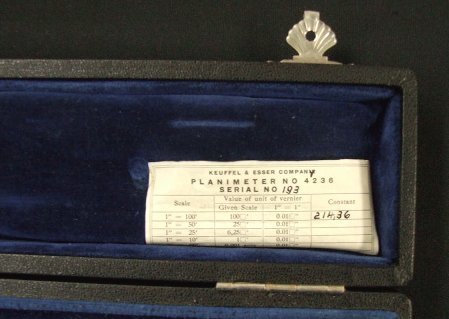Collection:
Juneau—Douglas City Museum
Object ID:
2007.22.149A—D
Accession#:
2007.22
Credit Line:
Transferred from the U.S. Bureau of Land Management.
Object Name:
Planimeter
Title:
Planimeter
Year Range from:
1950
Year Range to:
1996
Description:
Polar planimeter in a black box.
A. Adjustable tracer arm. Black and silver metal instrument with two white plastic dials in a cradle on one end and a sharp tracing tip at the other end. Stamped in the center of the main part of the instrument: "No 193'" in white ink. The two plastic dials are white with black lettering. They sit at a 90 degree angle to each other. The dial on top is scaled from 0 to 9. The dial that sits vertically is what is used to record the measurement. It is actually made of two separate parts that move individually. On one part the scale extends all the way around the dial from 0 to 9; on the other part the scale goes from 0 to 10 and is only on the top part of the dial.
B. Polar arm. A long black arm with a cylindrical weight attached to one end with a silver screw. At the other end is a cylinder of steel that tapers down into a spherical bead. This bead is designed to fit into a hole in the top of the tracer arm. In the center of the arm is stamped in white ink: "KEUFFEL & ESSER Co. GERMANY".
C. Steel Arm. Square steel arm. On one end there is a small screw on top and a small needle on the bottom; the other end is tapered and sloped. On that end is the following: "10".
D. Case. Black textured leather covering with a velvet blue insert cut to hold the instruments. Stamped on the outside cover in gold lettering: "K+E, KEUFFEL& ESSER Co." Latches are polished silver metal with a sea shell design. On the inside lid there is a piece of paper adheared to the velvet fabric. This paper is printed with the following: "KEUFFEL & ESSER COMPANY, PLANIMETER NO 4236, SERIAL NO 193. Scale 1"=100' Constant 214.36."
A. Adjustable tracer arm. Black and silver metal instrument with two white plastic dials in a cradle on one end and a sharp tracing tip at the other end. Stamped in the center of the main part of the instrument: "No 193'" in white ink. The two plastic dials are white with black lettering. They sit at a 90 degree angle to each other. The dial on top is scaled from 0 to 9. The dial that sits vertically is what is used to record the measurement. It is actually made of two separate parts that move individually. On one part the scale extends all the way around the dial from 0 to 9; on the other part the scale goes from 0 to 10 and is only on the top part of the dial.
B. Polar arm. A long black arm with a cylindrical weight attached to one end with a silver screw. At the other end is a cylinder of steel that tapers down into a spherical bead. This bead is designed to fit into a hole in the top of the tracer arm. In the center of the arm is stamped in white ink: "KEUFFEL & ESSER Co. GERMANY".
C. Steel Arm. Square steel arm. On one end there is a small screw on top and a small needle on the bottom; the other end is tapered and sloped. On that end is the following: "10".
D. Case. Black textured leather covering with a velvet blue insert cut to hold the instruments. Stamped on the outside cover in gold lettering: "K+E, KEUFFEL& ESSER Co." Latches are polished silver metal with a sea shell design. On the inside lid there is a piece of paper adheared to the velvet fabric. This paper is printed with the following: "KEUFFEL & ESSER COMPANY, PLANIMETER NO 4236, SERIAL NO 193. Scale 1"=100' Constant 214.36."
Notes:
A planimeter is a drafting instrument were used to measure two dimensional areas on a map. The region being measured may have an irregular shape. Basically one arm is kept stationary and the second arm is used to go around the outlide of the area on the map you want to measure. The dial in the center then measures how much area is within the outline of the spot you traced. See the document file for more information.
Search Terms:
JMIC
T&E
Drafting
Surveying
Mining
T&E
Drafting
Surveying
Mining


